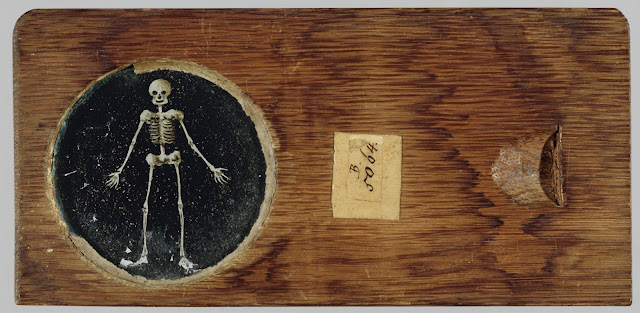 |
| Anonymous Dutch artist Skeleton ca. 1700-1800 oil paint on glass Rijksmuseum, Amsterdam |
 |
| Anonymous Dutch artist Two skeletons on gibbet regarded by standing nude man ca. 1793-1830 oil paint on glass Rijksmuseum, Amsterdam |
from Alastor, or, The Spirit of Solitude
There was a Poet whose untimely tomb
No human hands with pious reverence reared,
But the charmed eddies of autumnal winds
Built o'er his mouldering bones a pyramid
Of mouldering leaves in the waste wilderness: –
A lovely youth, – no mourning maiden decked
With weeping flowers, or votive cypress wreath,
The lone couch of his everlasting sleep: –
Gentle, and brave, and generous, – no lorn bard
Breathed o'er his dark fate one melodious sigh:
He lived, he died, he sung, in solitude.
Strangers have wept to hear his passionate notes,
And virgins, as unknown he passed, have pined
And wasted for fond love of his wild eyes.
The fire of those soft orbs has ceased to burn,
And Silence, too enamoured of that voice,
Locks its mute music in her rugged cell.
– Percy Bysshe Shelley (1815)
 |
| Alexander Cozens Rocky Bay Scene ca. 1759-65 oil on paper Tate Gallery |
 |
| Alexander Cozens The Cloud ca. 1770 watercolor Tate Gallery |
 |
| Jean-Frédéric Schall Evening Toilet ca. 1780-1820 oil on panel Rijksmuseum, Amsterdam |
 |
| Jean-Frédéric Schall Morning Toilet ca. 1780-1820 oil on panel Rijksmuseum, Amsterdam |
The Difficulty with a Tree
A woman was fighting a tree. The tree had come to rage at the woman's attack, breaking free from its earth it waddled at her with its great root feet.
Goddamn these sentiencies, roared the tree with birds shrieking in its branches.
Look out, you'll fall on me, you bastard, screamed the woman as she hit at the tree.
The tree whisked and whisked with its leafy branches.
The woman kicked and bit screaming, kill me kill me or I'll kill you!
Her husband seeing the commotion came running crying, what tree has lost patience?
The ax the ax, damnfool, the ax, she screamed.
Oh no, roared the tree dragging its long roots rhythmically limping like a sea lion towards her husband.
But oughtn't we to talk about this? cried her husband.
But oughtn't we to talk about this, mimicked his wife.
But what is this all about? he cried.
When you see me killing something you should reason that it will want to kill me back, she screamed.
But before her husband could decide what next action to perform the tree had killed both the wife and her husband.
Before the woman died she screamed, now do you see?
He said, what . . . ? And then he died.
– Russell Edson (1973)
 |
| Jan Ekels the Younger A man writing at his desk 1784 oil on panel Rijksmuseum, Amsterdam |
 |
| Jan Ekels the Younger A writer trimming his pen 1784 oil on panel Rijksmuseum, Amsterdam |
 |
| Francis Towne Rome - Arco Oscuro, Hollow Road 1780 watercolor British Museum |
 |
| Francis Towne Rome - Arco Oscuro, Hollow Road 1780 watercolor British Museum |
Road
This is what poetry is (says the Road),
a laying down of uniform pattern
across a land you can't control
but which you think it best to flatten.
It's far from vivid. Look at the whole
flamboyant forest! Look at the paths
that can't be uttered by a mouth
and at the scattered arcs of light
more integral to this wide planet
than words will ever be. Your lines?
Like railroad tracks that cut the bracken,
bring something through, then disappear.
No one knows what speck was taken
or where it moved, and no one cares.
– Lisa Williams (2001)
 |
| Pietro Longhi Portrait of a Venetian family with manservant serving coffee ca. 1752 oil on canvas Rijksmuseum, Amsterdam |
 |
| John Opie Self Portrait ca. 1790 oil on canvas Tate Gallery |
 |
| Charles de Wailly Design with Muses for coffered ceiling 1780 watercolor Cooper Hewitt, Smithsonian Design Museum |
 |
| Nicolas Dupin after Augustin de Saint Aubin Fashion plate - Marie Antoinette ca. 1787 hand-colored engraving Rijksmuseum, Amsterdam |
Poems from the archives of Poetry (Chicago)